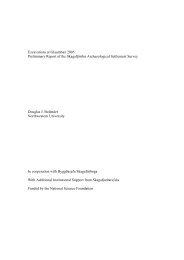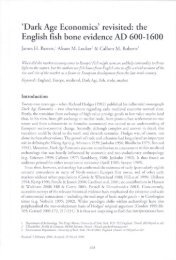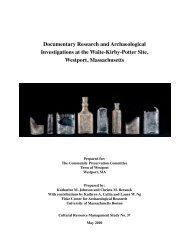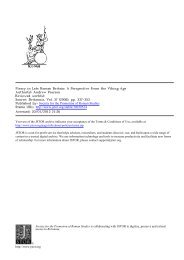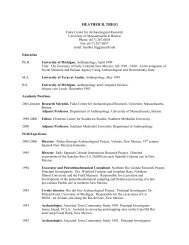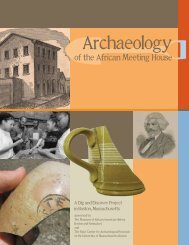archaeological site examination north yard of the ... - Fiske Center
archaeological site examination north yard of the ... - Fiske Center
archaeological site examination north yard of the ... - Fiske Center
You also want an ePaper? Increase the reach of your titles
YUMPU automatically turns print PDFs into web optimized ePapers that Google loves.
3. Middle Archaic Period (ca. 8,000-6,000 B.P.)<br />
During <strong>the</strong> Middle Archaic <strong>the</strong> New<br />
England landscape began to resemble that<br />
<strong>of</strong> today with <strong>the</strong> establishment <strong>of</strong> a deciduous<br />
forest and increased diversity <strong>of</strong> plant<br />
and animal foods (Dincauze 1976;<br />
Dincauze and Mulholland 1977). The number<br />
<strong>of</strong> <strong>archaeological</strong> <strong>site</strong>s from this period<br />
increases dramatically in comparison with<br />
<strong>the</strong> past period, suggesting a significant rise<br />
in population. The Merrimack River Valley<br />
associated with <strong>north</strong>ern Massachusetts and<br />
sou<strong>the</strong>rn New Hampshire, in particular,<br />
contain <strong>the</strong> best known <strong>site</strong>s <strong>of</strong> <strong>the</strong> period.<br />
These include <strong>the</strong> Neville and Smyth <strong>site</strong>s<br />
in New Hampshire (Dincause 1976;<br />
Kenyon 1983) and Shattuck Farm in<br />
Andover (Mahlstedt 1981; Leudtke 1985)<br />
Settlement in and exploitation <strong>of</strong> a variety<br />
<strong>of</strong> environments is clearly indicated by both<br />
faunal remains and tool kits and this was<br />
increasingly associated with seasonal<br />
resource availability (Dincauze and<br />
Mulholland 1977; Barber 1979).<br />
Andromous fishing at falls was clearly <strong>the</strong><br />
primary attraction at a number <strong>of</strong> localities<br />
including <strong>the</strong> Neville <strong>site</strong> that revealed evidence<br />
<strong>of</strong> reoccupation over a period <strong>of</strong><br />
time. The lithic tool kit during this period<br />
is characterized by three distinctive projectile<br />
point styles (Dincauze 1976). These<br />
include <strong>the</strong> Neville, Stark and Merrimack<br />
that are joined by atlatl weights, knives,<br />
perforators, axes, adzes, scrapers, abraders,<br />
ulus, gouges and harpoons (Donta et al<br />
2002).<br />
4. Late Archaic Period (ca. 6,000-3,000 B.P.)<br />
The greatest number <strong>of</strong> Native American<br />
<strong>archaeological</strong> <strong>site</strong>s in New England is<br />
associated with <strong>the</strong> Late Archaic. Seasonal<br />
temperatures were slightly higher than<br />
today and an oak-hickory forest came to<br />
dominate sou<strong>the</strong>rn New England (Loparto<br />
1986:7). The period is characterized by relatively<br />
high populations that occupied <strong>the</strong><br />
entire range <strong>of</strong> available environments for<br />
<strong>the</strong> purpose <strong>of</strong> exploiting an equally wide<br />
range <strong>of</strong> plant and animal resources.<br />
Seasonal settlement patterns continued, but<br />
toward <strong>the</strong> end <strong>of</strong> <strong>the</strong> period populations<br />
became more settled on <strong>the</strong> landscape as<br />
evidenced by shell middens and fish weirs.<br />
Coupled with this sedentism was limited<br />
cultivation <strong>of</strong> plant foods such as squash,<br />
gourds and sunflower.<br />
Three different lithic traditions suggest <strong>the</strong><br />
possible development <strong>of</strong> regional ethnic<br />
diversity (Dincauze 1974, 1975) or <strong>of</strong> differing<br />
tool kit functions. The Small-<br />
Stemmed point tradition is most widespread<br />
and is associated with indigenous populations<br />
that had long inhabited <strong>the</strong> region.<br />
The Laurentian tradition may represent a<br />
migration <strong>of</strong> peoples from <strong>the</strong> Great Lakes<br />
region where such tool kits are common.<br />
The Susquehanna tradition is generally<br />
associated with groups that derived from<br />
<strong>the</strong> Middle-Atlantic region. The mixture <strong>of</strong><br />
<strong>the</strong>se traditions in single <strong>site</strong>s suggests <strong>the</strong><br />
coexistence <strong>of</strong> <strong>the</strong> three groups and<br />
exchange <strong>of</strong> technologies (Dincauze 1976;<br />
Ritchie 1969; Snow 1980; Custer 1984;<br />
Bourque 1995). Evidence <strong>of</strong> religious<br />
beliefs from burials becomes more common<br />
during this period due to <strong>the</strong> use <strong>of</strong> particular<br />
practices that includes red ocher and<br />
burial goods.<br />
5. Early Woodland Period (ca. 3,000-1,600 B.P.)<br />
The Early Woodland is generally associated<br />
with a period <strong>of</strong> population reduction and a<br />
clustering <strong>of</strong> <strong>site</strong>s in valleys along river<br />
courses, but this characterization may be a<br />
product <strong>of</strong> sampling error. An expansion <strong>of</strong><br />
6



